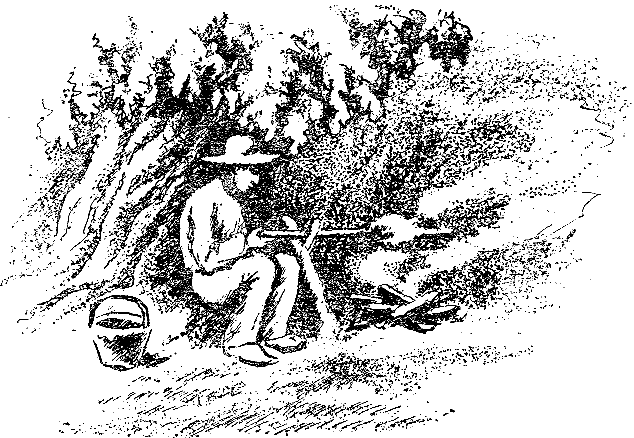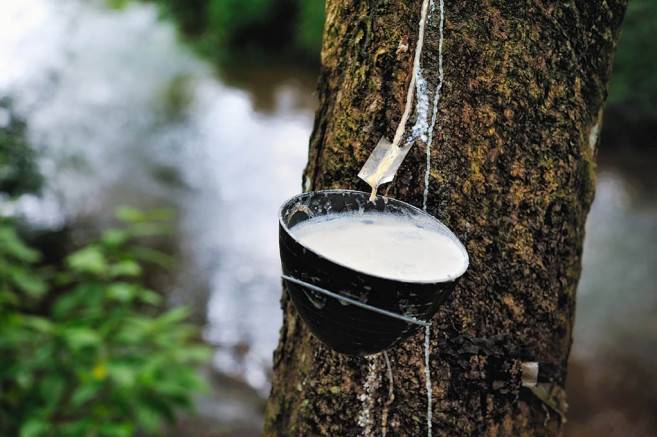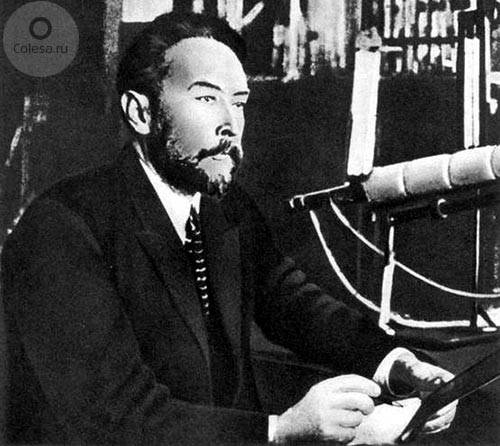Soviet rubber. 90 years of brilliant discovery
As you know, rubber got its name from the Indian word "rubber", which in translation meant "tree tears". So the Indians of South America called Hevea sap - Hevea brasiliensis, or "rubber tree". This juice darkened and hardened in the air, the resin “rubber” evaporated from it, which was used to manufacture vessels, fabrics and children's toys, including primitive balls. In 1735, the French traveler Charles Kondamin, who visited the Amazon basin, brought samples of products from the juice of a strange tree to Europe, after which not only naturalists, but also industrialists became interested in them. Experiments began on the use of rubber in the production of waterproof raincoats and shoes. Initially, in the second half of the XIX century, Brazil was the main monopolist in the production of the hevea. Later, the British and Dutch colonies in Southeast Asia, the Netherlands East Indies and British Malaya, took over the palm. It was there that a large number of rubber plantations appeared.

Requirements for rubber in Russia, and then in the Soviet Union, are constantly growing. Already in the early twentieth century, Russian Empire factories produced from rubber at least 11-12 thousand tons of rubber per year. After the revolution, the Soviet state, which took the path of industrializing the country, required an even greater amount of rubber. Only to create one car required 160 kilograms of rubber, for the aircraft - 600 kilograms of rubber, and for the ship - 68 tons. Meanwhile, the rubber remained imported and the country had to give huge money to exporting countries for its purchase. For example, one ton of rubber by the middle of 1920-s cost the Soviet budget about 2,5 thousands of gold rubles.
It was a lot of money, but a large role in the desire of the young Soviet state to get rid of the need to export large quantities of rubber was also played by political considerations. The Soviet Union was not going to depend entirely on the import of rubber and rubber products from other states, with which, moreover, very unfriendly relations were observed. Moreover, the memory was the sad experience of Germany, which during the First World War was isolated from the supply of rubber from the colonies of the Entente countries and this had a very negative impact on its defense capability.

Therefore, even in the distant 1926 year, the Soviet government announced a competition for the best work on the synthesis of rubber. Even an “astronomical” award was appointed at that time — a hundred thousand rubles. One of those who decided to try themselves in the most interesting scientific development - the creation of synthetic rubber - was the famous Russian and Soviet chemist Sergey Lebedev. By that time, it was already an experienced 52-year-old scientist, who began his professional career in pre-revolutionary Russia and achieved considerable success in it.
Sergey Vasilyevich Lebedev was born in 1874 year in Lublin (now it is the territory of Poland). Like many Russian scientists, he came from a varied environment. His father, a teacher of Russian literature by profession, became a priest in 32 year. By the way, the father of another eminent chemist Alexey Evgrafovich Favorsky was a village priest. Sergey Lebedev graduated from the Warsaw Gymnasium of 1, while still studying, he finally decided on his professional future and decided to devote himself to chemistry.
In 1900, 26-year-old Lebedev graduated from the natural department of the Physics and Mathematics Faculty of St. Petersburg University, receiving a first degree diploma. He got a job at the laboratory of the soap factory, which belonged to the Zhukov brothers, at the same time, as a part-time job, he taught physics at secondary schools. But this young naturalist was clearly not enough. In 1902, Sergey Vasilyevich received an invitation to a much more interesting position for him as a laboratory assistant in the department of technical and analytical chemistry at Petersburg University.
The well-known Russian chemist Alexey Evgrafovich Favorsky, who headed the Department of Technology and Technical Chemistry at St. Petersburg University since 1896, became a real teacher for Sergei Lebedev. It was from him that Lebedev studied in his student years, and it was he who later gave Lebedev advice entirely to go into science and focus his attention on the study of the phenomena of polymerization of unsaturated organic compounds. In 1906, Lebedev trained for some time in Paris, at the Sorbonne, with another well-known chemist of Russian origin, Viktor Henri, and then, returning to Russia, he focused entirely on scientific research.
 In 1913, Sergey Vasilyevich Lebedev defended his thesis and became a privat-associate professor at Petersburg University. He taught the course “The Modern State and Value of the Valency Study”. The development of national importance Lebedev began during the First World War, when the country experienced a great need for toluene. The chemist-chemist headed the chemical department of the Naftohaz plant, directly engaged in the production of toluene. After the October Revolution, like many other Russian scientists, Lebedev did not emigrate from the country. He accepted the new power and continued to work in the interests of his state. In 1925, Lebedev established an oil refining laboratory at Leningrad University. It was she who soon played a key role in the Soviet experiments on the creation of synthetic rubber. When in 1926, the Soviet government announced a competition for the development in the field of synthetic rubber, Sergei Lebedev's laboratory responded to this proposal.
In 1913, Sergey Vasilyevich Lebedev defended his thesis and became a privat-associate professor at Petersburg University. He taught the course “The Modern State and Value of the Valency Study”. The development of national importance Lebedev began during the First World War, when the country experienced a great need for toluene. The chemist-chemist headed the chemical department of the Naftohaz plant, directly engaged in the production of toluene. After the October Revolution, like many other Russian scientists, Lebedev did not emigrate from the country. He accepted the new power and continued to work in the interests of his state. In 1925, Lebedev established an oil refining laboratory at Leningrad University. It was she who soon played a key role in the Soviet experiments on the creation of synthetic rubber. When in 1926, the Soviet government announced a competition for the development in the field of synthetic rubber, Sergei Lebedev's laboratory responded to this proposal.It should be noted that the need of mankind in rubber continued to grow. It was used in various types of industry, so it was not surprising that in many countries of the world they tried to find an opportunity to synthesize rubber by chemical means. As early as the 19th century, chemists discovered that natural rubber is a compound of several chemicals, of which 90% is polyisoprene hydrocarbon. Such substances, as we know, belong to the group of polymers, which are high-molecular products, resulting from the combination of many identical molecules. The rubber, therefore, was the result of the combination of isoprene molecules. If favorable conditions existed, the molecules joined in long chains, i.e. underwent a polymerization process. Another 10% in the composition of rubber accounted for resinous substances of mineral and protein nature. It was these substances that gave rubber elasticity and strength.
Chemical scientists in the development of the synthesis of rubber had three tasks. Firstly, they had to learn how to synthesize isoprene, secondly, to polymerize it, and thirdly, to protect the rubber obtained as a result of the synthesis from decomposition. In 1860, Englishman Williams was able to get isoprene from rubber, and later 19 years, in 1879, Frenchman Bushard performed a reverse experiment - he obtained rubber from isoprene. In 1884, another Englishman, a chemist Tilden, isolated isoprene from turpentine. However, in spite of all the experiments listed above, it was not possible to adjust the production of synthetic rubber on an industrial scale. The complexity of technical processes, expensive raw materials - all this impeded the industrial production of synthetic rubber. Naturally, the impossibility of its production on an industrial scale played into the hands of the owners of the Hevea plantations and those countries that acted as exporters of rubber - Great Britain, the Netherlands, and Brazil.
Nevertheless, chemists did not leave any doubt as to whether isoprene is really needed for the manufacture of rubber or can be dispensed with using any other hydrocarbons. In 1901, the Russian scientist Kondakov as a result of another experiment found that dimethylbutadiene, if left for a year in a dark atmosphere, turns into a substance resembling rubber. During the First World War, Germany, which could not export rubber from the British and Dutch colonies, was forced to switch to rubber synthesis experiments using the Kondakov method, but the resulting products had very poor quality compared to natural rubber. Therefore, after the end of the First World War, the experiments on the creation of methyl rubber were discontinued and were no longer reproduced.
Taking up experiments on the synthesis of rubber, Sergey Lebedev and his assistants conducted them in very difficult conditions. There was not enough equipment or materials, so the Soviet chemists resorted to improvised means. So, in order to get ice for the experiment, Lebedev and his students went to the winter Neva. Sergey Vasilievich preferred not to experiment with isoprene, as his English and French predecessors, but chose divinyl. To receive divinyl, Lebedev first decided to extract it from oil, but then he stopped on alcohol. So it was found the cheapest and suitable initial raw materials. However, a suitable catalyst was needed that would allow the decomposition of ethyl alcohol into divinyl, hydrogen and water. Sergei Lebedev long thought about what can be used as a catalyst, but then he stopped on one of the natural clays. In 1927, he traveled to the south of the country, where he began studying clay samples in the North Caucasus and the Crimea. The most suitable version of the clay was discovered by scientists at Koktebel, which made it possible to significantly speed up the experiments. Already at the end of 1927, Sergei Vasilievich was able to conduct a long-awaited operation to obtain divinyl from alcohol. It was possible to say that the initial stage of the experiment on the synthesis of rubber was completed successfully. Next, Lebedev began the polymerization of divinyl. He spent it with metallic sodium, and at the final stage the obtained rubber was mixed with magnesia, kaolin, and soot to prevent decomposition.
At the end of December, 1927, Sergey Lebedev and his assistants, managed to complete the experiment. Two kilograms of the rubber obtained as a result of the experiment was sent to Moscow - to the jury of the competition of the Supreme Economic Council. 1 January 1928, the jury received material - two kilograms of synthetic sodium-butadiene rubber, as well as related technical documents. The experiment ended with the victory of Sergei Lebedev, for which the scientist received an award. The Soviet state began to provide technical and economic conditions for the organization of mass production of synthetic rubber. In 1930, the first pilot plant for the production of synthetic rubber based on the technology of Sergey Lebedev was built, and in the next 1931, the scientist was awarded the Order of Lenin for special achievements in solving the problem of obtaining synthetic rubber. Sergey Vasilyevich was elected to the Academy of Sciences and became one of the recognized authorities of Soviet chemical science.
For the Soviet state, Lebedev’s experiment was of decisive importance. Thus, it is difficult to overestimate its consequences for the victory of the Soviet Union in the Great Patriotic War. In 1930 in the USSR, several factories for the production of synthetic rubber were established, each of which produced at least 10 thousand tons of rubber per year. Factories operated in Efremov, Yaroslavl, Voronezh, Kazan and used food products as raw materials, first of all - potatoes. The problem of replacing imported rubber with high-quality synthetic rubber has been solved. Now, in order to provide one Soviet car with rubber, it was no longer necessary to buy rubber at great prices from the British or the Dutch - it was enough to put about 500 kg of potatoes at a rubber factory. Already in 1934, 11 thousand tons of synthetic rubber were produced in the USSR, 1935 thousand tons in 25, 1936 thousand tons of rubber in 40 year. Dependence on rubber imports has been overcome. Unfortunately, Sergey Vasilyevich Lebedev himself managed very briefly to observe the triumph of his brainchild. In 1934, he fell ill with typhus and died at the age of sixty. But the experiment on the creation of artificial rubber perpetuated his name for posterity.
During the Great Patriotic War, the Soviet rubber industry was able to meet the needs of the military-industrial complex, as for cars, armored vehicles, tanks, aircraft and ships needed more and more rubber. But even after the war, until 1991, the Soviet Union remained the world leader in the production of artificial rubber. Unfortunately, the collapse of the great state only radically changed the situation.
Information